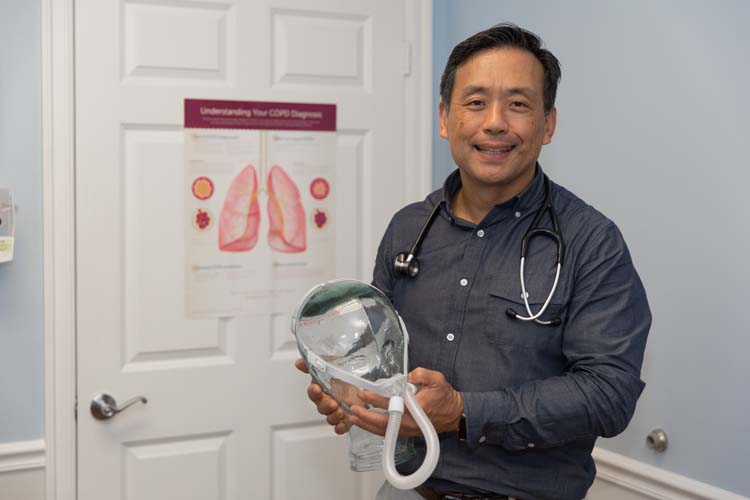
There is important news for the more than 25 million U.S. adults who suffer from obstructive sleep apnea (OSA): A study from Johns Hopkins University has shown that the condition, if left untreated even for a few days, can negatively impact important metabolic functions.
OSA occurs when the upper airway closes off during sleep, temporarily interrupting breathing, and the study found untreated OSA can elevate blood pressure, increase sugar and fat levels in the blood, and raise the number of stress hormones produced by our bodies.
Dr. John Suen is the Medical Director of Sleep Disorders Center Florida, located in Vero Beach. He is familiar with the study, published in the August issue of the Journal of Clinical Endocrinology & Metabolism, and says its results were highly anticipated.
“Other studies have reached similar conclusions,” Dr. Suen says, “but this one was particularly well-designed and the results are very convincing.”
Previous studies in patients with OSA usually collected data while participants were awake, only documenting the aftermath of OSA. Jonathan Jun, MD, assistant professor of medicine at the Johns Hopkins University School of Medicine and the paper’s senior author, says, “This is one of the first studies to show real-time effects of sleep apnea on metabolism during the night.”
The study reinforces the importance of treating OSA every night; treatment usually takes the form of a “continuous positive airway pressure” (CPAP) machine. CPAP machines deliver air pressure during sleep, through a mask placed over the nose. With CPAP, the air pressure is higher than that of the surrounding air, which keeps the upper airway passages open.
To better understand how OSA affects metabolism – the life-sustaining chemical processes that occur within our bodies – the researchers performed a number of metabolism-related measurements when the sleeping study participants were using a CPAP machine and when the CPAP machine was withdrawn.
Dr. Jun and his colleagues found that CPAP withdrawal caused increased levels of fatty acids, glucose, and cortisol (a stress hormone); blood pressure also increased. Significantly, the more severe the OSA, the more those measurements increased when the CPAP was withdrawn.
Vero’s Dr. Suen says the increase in fatty acids and blood pressure can raise the risk of strokes and heart attacks and, in another cardiovascular consequence, the increase in cortisol can cause damage to blood vessels.
While OSA has long been linked to obesity, diabetes, and cardiovascular disease, the researchers say their study provides evidence that sleep apnea isn’t just a manifestation of these conditions; it can also directly aggravate them.
The most common symptoms of OSA include loud snoring, abrupt awakenings accompanied by shortness of breath, trouble staying asleep, and excessive daytime sleepiness. There are also often noticeable signs upon awakening, including a dry mouth, sore throat or headache.
While OSA can affect anyone, there are certain key risk factors:
- Excess weight. People who are obese have four times the risk of sleep apnea that people who are a normal weight people do. Fat deposits around the upper airway may obstruct their breathing.
- Neck circumference. People with thicker necks may have narrower airways. For men, the risk increases if neck circumference is 17 inches (43 centimeters) and larger. In women, the risk increases if neck circumference is 15 inches (38 centimeters) or more.
- Use of alcohol, sedatives or tranquilizers. These substances relax the muscles in the throat and increase the risk.
Other risk factors include being male, being older, smoking, a family history of OSA, and any sort of difficulty with nose-breathing.
The use of a CPAP machine can, at first, be both uncomfortable and claustrophobic. A good starting point is to choose the right CPAP mask for your face shape and sleeping habits; there are a range of styles and sizes available. Dr. Suen says that there have been many improvements in CPAP masks in recent years: they are lighter and smaller, often covering just the nose rather than the nose and mouth.
The machines themselves have also evolved. “Most machines now have adjustments that allow the air pressure to ramp up gradually, which helps the person get acclimated,” Dr. Suen says. “And water chambers within the machine provide a humidifier effect, which helps avoid the dryness that can result from the use of this type of device.”
Dr. Suen also says that for those who can’t tolerate a CPAP machine (or are simply looking for an alternative), “oral appliance therapy” may be a viable option. A custom-fit oral sleep appliance is made using digital or physical models of the patient’s teeth; these models are sent to a dental lab where the appliance is made.
A doctor, dentist or a sleep specialist can help sufferers make the right treatment choice; the important thing is that OSA must not go untreated.
Sleep Disorders Center Florida is an accredited medical treatment center for all sleep-related issues. It is located at 3735 11th Circle #103 in Vero Beach; the phone number is 772-563-2910.



